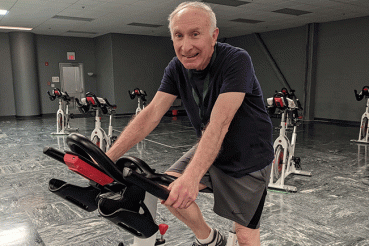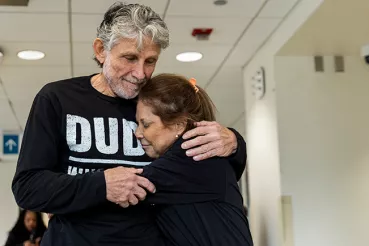In early October of 2018, Patricia Worley got up in the middle of the night to use the bathroom. She fell, hitting her head and causing a concussion. She was recovering well until she lost her balance a month later and hit her head on the sidewalk while attempting to move a big plant. Suffering from two concussions, she experienced dizziness, headaches and impaired balance which caused difficulty walking. A volunteer at her church and at the hospital, Patricia couldn’t drive or volunteer and feared losing her independence. Her doctor referred her to Rush Copley’s Outpatient Rehabilitation & Therapy Center for physical therapy.
For five months, she attended concussion management therapy twice a week, working with Physical Therapist Louela Velasco and Neuro Clinical Specialist Jeannie Liu on balance and coordinating her eye movement to decrease her dizziness. Because Patricia experienced visual vertigo, she was sensitive to light, sound and busy environments.
Debilitating Problems
The therapists used the Bertec System as part of her treatment. The system is used as both an assessment and training tool. It objectively measures a patient’s balance and can then be used to train the individual to overcome deficits, providing treatment protocols that target specific impairments.
“Most healthy people don’t find it difficult to walk in darkness, on gravel driveways or at a busy shopping mall, “ Velasco said, “but in some people with dizziness and imbalance problems, this can be debilitating and lead to falls, greatly limiting function, mobility and quality of life. Historically, evaluating and treating patients with balance problems has been a great challenge to health care professionals, but with advanced technology – in combination with a thorough clinical assessment and knowledge of underlying pathology – this can be effectively managed.”
State-of-the-Art Technology
“The use of advanced technology positions us as a specialized provider and differentiates our facility as one that provides state-of-the-art service in treating balance and mobility problems,” Velasco said.
The Bertec’s assessment tool provides objective information to accurately identify and isolate specific balance impairment under a variety of changing task conditions which are critical to daily life, she said. She explained that a person has three balance systems and any of them could be off: somatosensory (joints and muscles); visual, which tells the brain if the environment is moving or still; and vestibular (inner ear). “It evaluates how well the patient uses their somatosensory, visual, and vestibular cues for balance,” she said. “It also evaluates the patient’s automatic motor response with external perturbation and when there is a sudden change in surface.”
Customized Treatment
Once the patient’s deficits are assessed, the results are sent to the doctor and treatment is customized. After four to six weeks of treatment, the patient is retested.
In Patricia’s case, as a result of the concussion, her balance was below the normal range for someone her age. To retrain her ability to deal with a busy environment while improving her balance, the Bertec system’s grocery store simulation was used. Patricia stood on a moveable platform in front of a screen which simulated a grocery shopping experience with objects in the aisle lighting up so she would have to maneuver around them. The system includes a harness as a safety measure to prevent falling. “You move your body as the circles light up,” Patricia explained. “It was very helpful. It taught me to move this way or that. Before when I walked, it was like I was weaving.”
The programs trained her ability to balance through her visual and vestibular systems. Liu explained, “The screen presents a visual that changes and the floor moves beneath her feet. The program retrains her brain to tolerate the busy environment.”
The difficulty level can be adjusted to match the patient’s ability and then increased to challenge the patient even more, assisting in recovery and improving quality of life.
Return to Activities
After five months of treatment, she was able to return to her prior functions of driving and volunteering. “She had a great outcome and was so happy,” Liu said.
The use of the Bertec system accounted for about 10 to 15 minutes of each therapy session. Patricia’s therapy involved other balance training techniques as well, including the use of a rocker board, support surfaces of varying foam densities, balance beam and other equipment, and eye exercises for ocular motor dysfunction.
Patients are referred for therapy when they are not recovering in the expected timeframe. The therapists see concussions resulting from sports activities, car accidents and falls.
A Great Outcome
“My balance was off and I had trouble with my eyes,” Patricia said. “I never felt like myself. By the time I finished therapy in March, I was much, much better.
“It was a very difficult five months,” she continued. “Jeannie and Lou were both wonderful working with me to gain back my balance. I can’t say enough about them. You couldn’t ask for anyone to do more. Without them, I don’t know what would have happened to me.”
Patricia called the Bertec a “wonderful machine” and said the therapy was very helpful. “Without it, I don’t know where I would be.”




